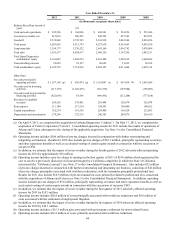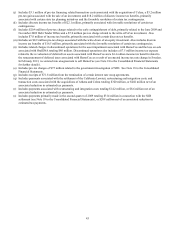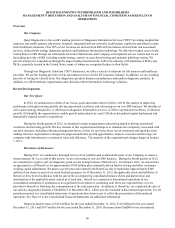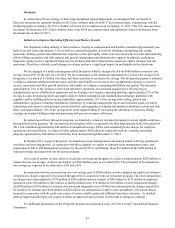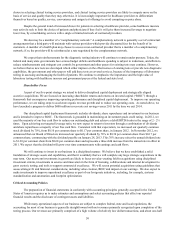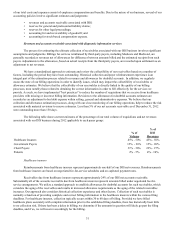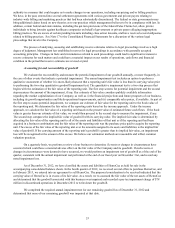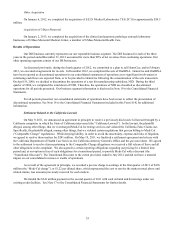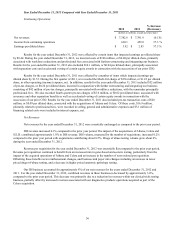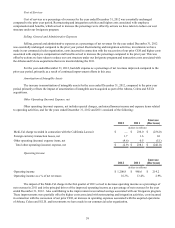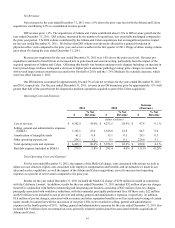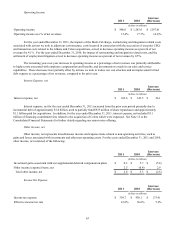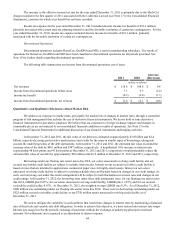Quest Diagnostics 2012 Annual Report Download - page 57
Download and view the complete annual report
Please find page 57 of the 2012 Quest Diagnostics annual report below. You can navigate through the pages in the report by either clicking on the pages listed below, or by using the keyword search tool below to find specific information within the annual report.54
Accounting for stock-based compensation expense
We record stock-based compensation as a charge to earnings, net of the estimated impact of forfeited awards. As such,
we recognize stock-based compensation cost only for those stock-based awards that are estimated to ultimately vest over their
requisite service period, based on the vesting provisions of the individual grants. The process of estimating the fair value of
stock-based compensation awards and recognizing stock-based compensation cost over their requisite service periods involves
significant assumptions and judgments.
We estimate the fair value of stock option awards on the date of grant using a lattice-based option-valuation model
which requires management to make certain assumptions regarding: (i) the expected volatility in the market price of the
Company's common stock; (ii) dividend yield; (iii) risk-free interest rates; and (iv) the period of time employees are expected to
hold the award prior to exercise (referred to as the expected holding period). The expected volatility under the lattice-based
option-valuation model is based on the current and historical implied volatilities from traded options of our common stock. The
dividend yield is based on the approved annual dividend rate in effect and current market price of the underlying common stock
at the time of grant. The risk-free interest rate is based on the U.S. Treasury yield curve in effect at the time of grant for bonds
with maturities ranging from one month to ten years. The expected holding period of the awards granted is estimated using the
historical exercise behavior of employees. In addition, we estimate the expected impact of forfeited awards and recognize
stock-based compensation cost only for those awards expected to vest. We use historical experience to estimate projected
forfeitures. If actual forfeiture rates are materially different from our estimates, stock-based compensation expense could be
significantly different from what we have recorded in the current period. We periodically review actual forfeiture experience
and revise our estimates, as considered necessary. The cumulative effect on current and prior periods of a change in the
estimated forfeiture rate is recognized as compensation cost in earnings in the period of the revision.
The terms of our performance share unit grants allow the recipients of such awards to earn a variable number of shares
based on the achievement of the performance goals specified in the awards. Stock-based compensation expense associated with
performance share units is recognized based on management's best estimates of the achievement of the performance goals
specified in such awards and the resulting number of shares that will be earned. If the actual number of performance share units
earned is different from our estimates, stock-based compensation could be significantly different from what we have recorded
in the current period. The cumulative effect on current and prior periods of a change in the estimated number of performance
share units expected to be earned is recognized as compensation cost in earnings in the period of the revision. While the
assumptions used to calculate and account for stock-based compensation awards represent management's best estimates, these
estimates involve inherent uncertainties and the application of management's judgment. As a result, if revisions are made to our
assumptions and estimates, our stock-based compensation expense could vary significantly from period to period. In addition,
the number of awards made under our equity compensation plans, changes in the design of those plans, the price of our shares
and the performance of our Company can all cause stock-based compensation expense to vary from period to period.
Acquisitions
Acquisition of Athena Diagnostics
On February 24, 2011, we signed a definitive agreement to acquire Athena Diagnostics (“Athena”) from Thermo
Fisher Scientific, Inc., in an all-cash transaction valued at approximately $740 million. Athena is the leading provider of
advanced diagnostic tests related to neurological conditions. We completed the acquisition of Athena on April 4, 2011 (see Note
5 to the Consolidated Financial Statements for further details).
Acquisition of Celera Corporation
On March 17, 2011, we entered into a definitive merger agreement with Celera Corporation (“Celera”) under which
we agreed to acquire Celera for $8 per share, in a transaction valued at approximately $344 million, net of $326 million in
acquired cash and short-term marketable securities. Additionally, we expect to utilize Celera's available tax credits, net
operating loss carryforwards and capitalized tax research and development expenditures to reduce our future tax payments by
approximately $110 million. Celera is a healthcare business focused on the integration of genetic testing into routine clinical
care through a combination of products and services incorporating proprietary discoveries. Celera offers a portfolio of clinical
laboratory tests and disease management services associated with cardiovascular disease. In addition, Celera develops,
manufactures and oversees the commercialization of molecular diagnostic products, and has licensed other relevant diagnostic
technologies developed to provide personalized disease management in cancer and liver diseases. We completed the
acquisition of Celera on May 17, 2011 (see Note 5 to the Consolidated Financial Statements for further details).


